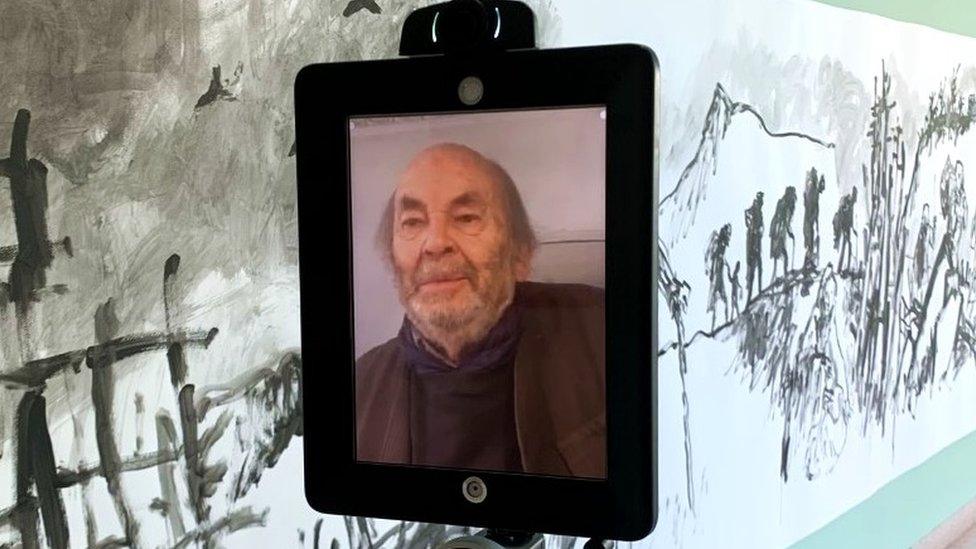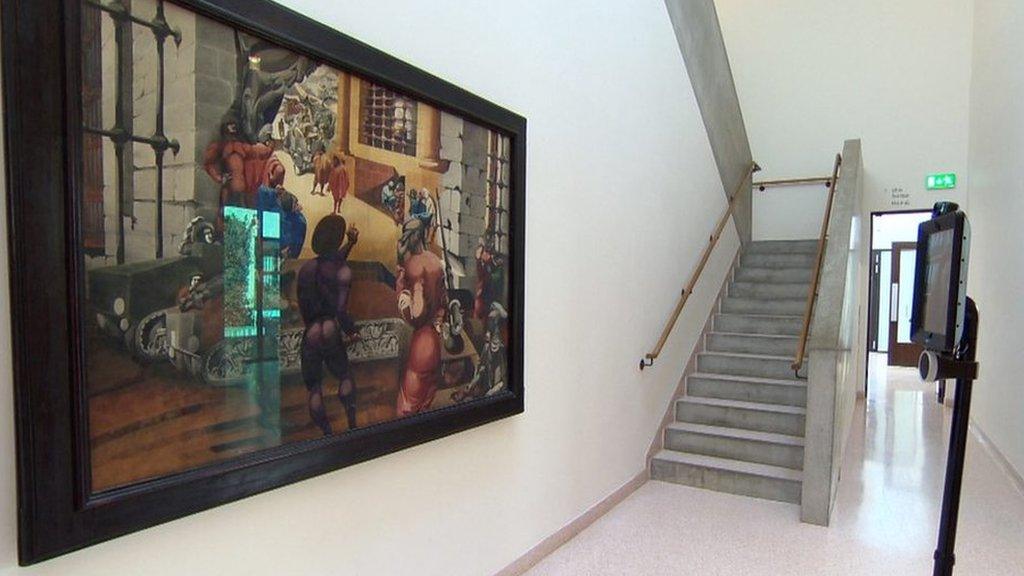Sir Quentin Blake does 'The Robot'
- Published

The cartoonist and illustrator Sir Quentin Blake is famous for his collaborations with the writers Roald Dahl and David Walliams.
But now he has stumbled on a story of his own involving a mysterious taxi driver and a robot.
Sir Quentin has created a massive new artwork following a "bizarre" encounter with a taxi driver two years ago.
"We live in worrying times," the driver had told Sir Quentin, when he picked him up from his home.
"He [the taxi driver] went on to say that he'd seen Picasso's Guernica a couple of times in Spain. And then he said, 'what we need is a picture like that for our time and you are the person to do it.'"
Sir Quentin could not resist the challenge and felt: "I must try something."
Picasso painted his monumental masterpiece depicting the destruction in the Spanish Civil in 1937.
Sir Quentin knew his picture would be very different. But, before lockdown, he put a 30-foot (9m) long roll of paper on a wall at Hastings Contemporary Art Gallery in East Sussex, took a big brush in hand - and began to paint.

Quentin Blake's The Taxi Driver, acrylic paint on paper


We Live In Worrying Times by Sir Quentin Blake, watercolour, pen and ink on watercolour paper
"I called the picture The Taxi Driver because of the taxi driver, but it was supposed to be a gamut of terrible things that were happening to people in Europe and elsewhere," he explained.
"So there were troops of people who were migrants, there were bombed buildings... and a lot of other distressing things.
"I just started to draw on the left and moved across to the right and it ended rather tragically with someone who was a dead figure and I made it up as I went along."
'We Live in Worrying Times'
He completed the "narrative picture" in a day. It forms the centrepiece of a new exhibition called We Live in Worrying Times, which was due to open at Hastings Contemporary last month.
But the coronavirus pandemic put paid to that.
At the age of 87, Sir Quentin is self-isolating. And the Museum has been closed to the public since March.
That, though, is where the robot comes in.
A camera, mounted on a thin black pole attached to wheels, is able to tour the gallery and stream pictures back to viewers watching on their computers at home.
Up to five people at a time, plus an operator, can join the tour and explore and examine Sir Quentin's new work.
Although he is "deeply disappointed" people cannot see it in person, he is "delighted" the robot means they can view it online.
The robot tours the gallery
The exhibition also contains more than 170 new drawings and paintings, which are much more serious than the illustrations Sir Quentin is best known for.
"I suppose I have a reputation for being cheerful," he said.
Nonetheless, "it was something that was becoming apparent in my work. It was getting more sombre… so in a way I felt I was moving in this direction already.
"So in this exhibition you'll find, for instance, a set of drawings called Unfortunates. I imagine various people who are perhaps homeless or reduced to penury.
"And then there's another series which is called Perplexed and they are obviously adolescents, they're teenagers, that's just portraits of their faces, and they don't know what's going on."

When Quentin Blake first planned the exhibition he wanted to salute people experiencing distress, dislocation - and isolation. Little did he know how topical it would become.
"It was all done before anything that's happening now was happening. When I drew these pictures they were other people elsewhere in Europe and the East who were suffering from misfortunes.
"But it's rather strange that when show itself came on we suddenly find that we too are living in worrying times."
And what of the taxi driver who inspired the exhibition?
"This is all part of the strangeness of it," mused Sir Quentin. "I said, 'would you like to give me your name so I can tell you what happens?' And he said, 'no, no I keep an eye on everything."

Follow us on Facebook, external or on Twitter @BBCNewsEnts, external. If you have a story suggestion email entertainment.news@bbc.co.uk, external.
- Published3 April 2020
